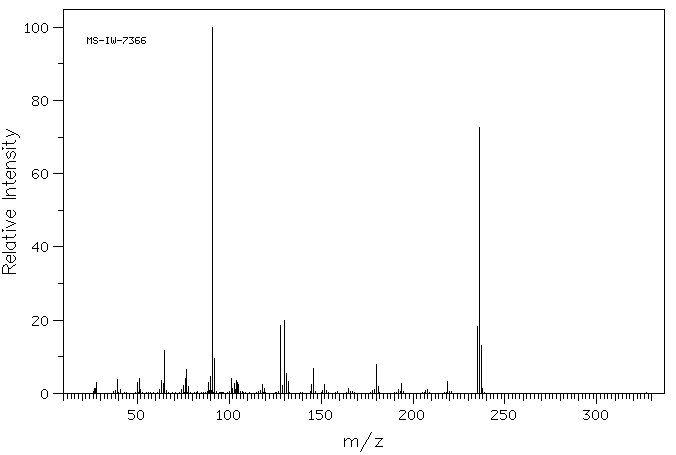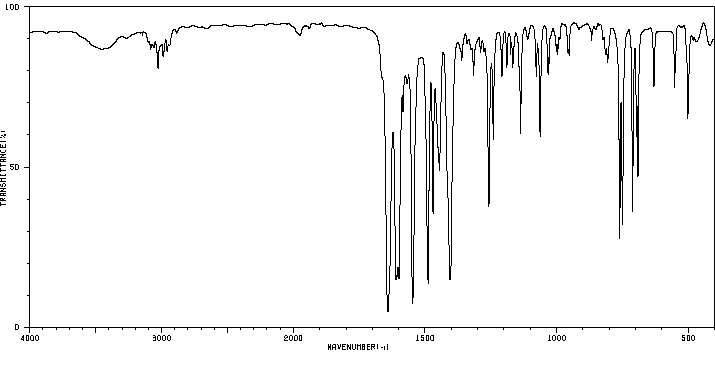1-Benzyl-1,4-dihydro-4-quinazolon | 92437-29-1
中文名称
——
中文别名
——
英文名称
1-Benzyl-1,4-dihydro-4-quinazolon
英文别名
1-Benzyl-1,4-dihydrochinazolin-4-on;1-benzylquinazolin-4(1H)-one;1-benzyl-1H-quinazolin-4-one;1-benzylquinazolin-4-one
CAS
92437-29-1
化学式
C15H12N2O
mdl
——
分子量
236.273
InChiKey
VMGQQUFKLFUSDE-UHFFFAOYSA-N
BEILSTEIN
——
EINECS
——
-
物化性质
-
计算性质
-
ADMET
-
安全信息
-
SDS
-
制备方法与用途
-
上下游信息
-
文献信息
-
表征谱图
-
同类化合物
-
相关功能分类
-
相关结构分类
计算性质
-
辛醇/水分配系数(LogP):2.4
-
重原子数:18
-
可旋转键数:2
-
环数:3.0
-
sp3杂化的碳原子比例:0.07
-
拓扑面积:32.7
-
氢给体数:0
-
氢受体数:1
安全信息
-
海关编码:2933990090
反应信息
-
作为反应物:描述:1-Benzyl-1,4-dihydro-4-quinazolon 在 palladium 10% on activated carbon 作用下, 以 乙醇 为溶剂, 以92 %的产率得到1‐benzyl‐2,3‐dihydroquinazolin‐4(1H)‐one参考文献:名称:作为靶向 AKR1B1 的有效选择性抑制剂的新型喹唑啉-4(1H)-酮衍生物的设计与合成摘要:抑制醛糖还原酶 (AKR1B1) 是治疗糖尿病并发症的一个很有前途的选择。然而,大多数已开发的小分子抑制剂缺乏选择性或生物活性低。为了解决这一局限性,设计并合成了一系列新的喹唑啉-4(1 H )-酮衍生物作为 AKR1B1 的有效和选择性抑制剂。新型化合物的醛糖还原酶抑制活性的特征在于 IC 50值范围为 0.015 至 31.497 μM。还记录了这些衍生物显着增强的选择性,对接研究进一步支持了这一点。在这些抑制剂中,化合物5g表现出最高的抑制活性,选择性指数达到1190.8。结构-活性关系突出了 N1-乙酸和 N3-苄基在 quinazolin-4(1 H )-one 支架上具有吸电子取代基对于构建高效和选择性 AKR1B1 抑制剂的重要性。DOI:10.1002/ardp.202200577
-
作为产物:描述:靛红 在 ammonium acetate 、 双氧水 、 potassium carbonate 、 sodium hydroxide 作用下, 以 水 、 N,N-二甲基甲酰胺 为溶剂, 反应 3.0h, 生成 1-Benzyl-1,4-dihydro-4-quinazolon参考文献:名称:在无溶剂条件下合成 1-取代 4(1H)-喹唑啉酮摘要:摘要 在无溶剂条件下加热 2-(N-烷基氨基)苯甲酸、原甲酸三乙酯和乙酸铵的混合物,以 73-99% 的产率生成 1-取代的 4(1H)-喹唑啉酮。此外,还提出了可能的反应途径。图形概要DOI:10.1080/00397911.2011.566407
表征谱图
-
氢谱1HNMR
-
质谱MS
-
碳谱13CNMR
-
红外IR
-
拉曼Raman
-
峰位数据
-
峰位匹配
-
表征信息
同类化合物
(12羟基吲[2,1-b〕喹唑啉-6(12H)-酮)
黑暗猝灭剂BHQ-3,BHQ-3NHS
鸭嘴花酚碱
鸭嘴花碱酮;(S)-2,3-二氢-3,7-二羟基吡咯并[2,1-b]喹唑啉-9(1H)-酮
鸭嘴花碱酮
鸭嘴花碱盐酸盐
鲁米诺单钠盐
鲁米诺
骆驼蓬碱
颜料蓝64
颜料蓝60
顺式-卤夫酮
顺式-(喹喔啉-2-基)丙烯腈1,4-二氧化物
非奈利酮
青黛酮
雷替曲塞杂质1
阿法替尼杂质J
阿法替尼杂质I
阿法替尼杂质28
阿法替尼杂质18
阿法替尼杂质13
阿法替尼杂质
阿法替尼中间体
阿法替尼
阿法替尼
阿朴藏红
阿巴康唑
阿夫唑嗪杂质A
阿夫唑嗪杂质
阿夫唑嗪EP杂质C
阿夫唑嗪
阿喹司特
阿呋唑嗪杂质
阿呋唑嗪杂质
铜迈星
铁诱导细胞死亡激活剂
钠四丙基硼酸酯
酸性蓝98
酸性红101
酮色林醇
酞联氮基[2,3-b]酞嗪-5,14-二酮,7,12-二氢-
酞嗪-5-羧酸
酞嗪-2-氧化物
酚藏花红
酚嗪
酒石酸溴莫尼定
邻苯二甲酰肼
还原黄6GD
还原蓝6
达尼喹酮








